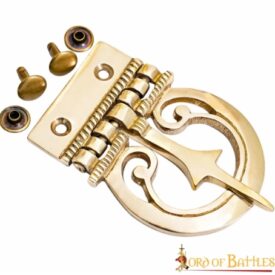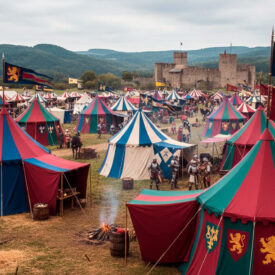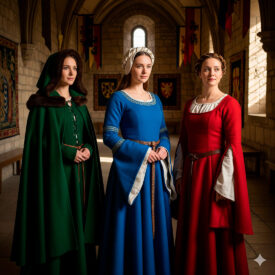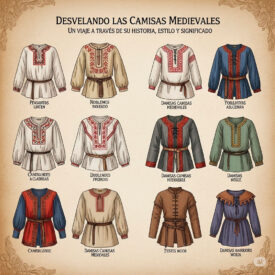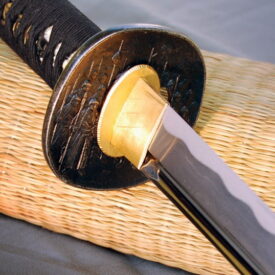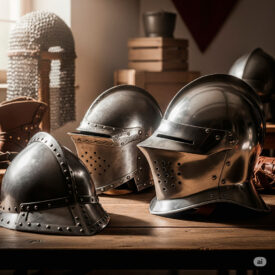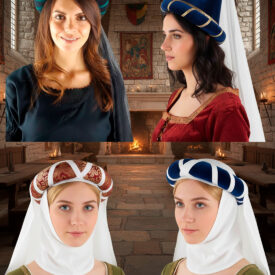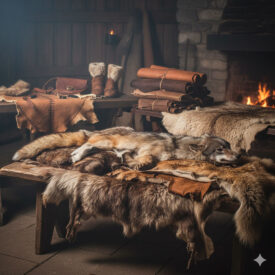The Middle Ages, a historical period spanning from the 5th to the 15th century, is remembered not only for its conflicts and social changes but also for its rich clothing. Medieval costumes were not merely garments; they were an expression of status, profession and regional identity, reflecting the complexity of a stratified society. This article will guide you through the evolution of medieval fashion, highlighting its meaning and legacy today, immersing you in a journey through fabrics, cuts and customs that defined the appearance of men and women for a thousand years.
Medieval Costumes: A Reflection of Society
Medieval dress was influenced by numerous factors, including geography, climate, available materials and, above all, social status. The diversity of clothing was notable, from the humble fabrics of peasants to the luxurious silks and velvets of the nobility. Understanding medieval costumes is to delve into the very structure of the society of the time.

- Historical context and evolution of fashion: The Middle Ages, which roughly extends from the 5th to the 15th century, was a period of great social, political and cultural transformations in Europe. This vast era is often divided into the Early, High and Late Middle Ages, and fashion evolved significantly in each of these phases. During the Early Middle Ages (c. 500–1000 AD), clothing was simpler and more functional, with Roman and barbarian influences. In the High Middle Ages (c. 1000–1300 AD), fashion began to become more structured and class-differentiated, with the appearance of new tailoring techniques and the use of more colors. The Late Middle Ages (c. 1300–1500 AD) saw fashion reach its greatest sophistication, with more body-fitting garments, the development of tailoring and an explosion of styles and ornamentation. Throughout these centuries, medieval costumes not only fulfilled a practical role of protection and warmth but also served as an important indicator of a person’s social status, profession and regional identity. Medieval costumes varied enormously in terms of materials, colors and designs, reflecting the social stratification and geographic differences of the time.
- Cultural and social importance: Medieval clothing carried deep cultural and social meaning. The colors, materials and style of a garment could communicate a great deal about the wearer, from their social and economic rank to their occupation and even their moral standing according to the rules of the time. The Church, the nobility and artisan guilds exerted strong influence over fashion, dictating trends and establishing rules about what could be worn and by whom, thus reinforcing social hierarchies and roles within medieval society. Sumptuary laws, for example, were decrees issued by authorities to regulate luxury and ostentation in dress, aimed at maintaining social order and preventing lower classes from imitating the nobility’s lifestyle. These laws dictated which fabrics, colors, ornaments and garment lengths were permitted for each social stratum, turning medieval costumes into a visual code of society.
Diversity of Costumes in the Middle Ages: A Social and Regional Mosaic
The social stratification of the Middle Ages was clearly reflected in clothing. Nobles wore fine fabrics and bright colors, while peasants used more functional garments made of sturdy materials. Regional differences also played an important role, giving rise to a rich variety of styles across Europe, making medieval costumes a true cultural mosaic.

- Costumes by social class: Clothing in the Middle Ages varied considerably depending on an individual’s social class. The nobility could afford garments made from fine imported fabrics such as silk, brocade and velvet, adorned with exotic furs (such as ermine or sable), jewelry and complex gold and silver embroidery. Their garments often included long capes, fitted tunics called cotte or cotehardies, and overgarments. On the other hand, the working classes wore simpler, more functional clothes made of wool or linen, which were durable and suitable for daily work in the fields or workshop. Their outfits mainly consisted of loose tunics, hose or breeches for men, and simple headdresses for women. This contrast in dress emphasized social divisions and helped maintain the established order, making status identifiable at a glance through medieval costumes.
- Regional differences: Climatic and cultural differences across Europe also influenced medieval fashion. In the colder northern regions, such as Scandinavia or England, garments were heavier and more functional, designed to provide warmth, with thick layers and furs. In the south, where temperatures were warmer, such as in Italy or southern France, fabrics were lighter (linen, cotton, silks) and clothing looser, with greater emphasis on drape and fall. In addition, cultural influences from neighbors and invaders, such as the Moors in Spain, introduced unique elements into local fashion, like the use of turbans or geometric patterns in fabrics. The Silk Road also brought eastern influences to the medieval costumes of the European nobility.
Materials and Construction Techniques: The Craft behind Medieval Costumes
The materials used to make medieval costumes varied widely, from wools to linens and silks, each chosen for availability, cost and status. Construction techniques were equally varied, reflecting the ingenuity and creativity of the period’s craftsmen.
- Fabrics and materials used: The availability of materials varied significantly from region to region, directly influencing the types of garments produced. Wool was the most common material, used in a range of qualities depending on the wearer’s wealth, from coarse wool for peasants to finely combed wool for the nobility. Linen was used for underwear, shirts and summer garments, prized for its coolness and absorbency. Silk, much more expensive, was reserved for high society and was imported mainly from Byzantium and, later, from Italy. Other materials included cotton (less common in Europe until the Late Middle Ages), hemp and leather, used for shoes, belts, bags and some outerwear or protective pieces. Natural dyes derived from plants, insects or minerals gave medieval costumes their vibrant color palette, although the brightest and most long-lasting dyes were more expensive and therefore associated with wealth.
- Construction methods: Making medieval garments was a labor-intensive process that required specialized skills. Before the invention of the sewing machine, all clothing was made by hand, which made garments expensive and valued. Tailors and seamstresses, often organized into guilds, followed traditional techniques passed down from generation to generation to create everything from simple tunics to complex ceremonial attire. Fabric cutting was ingenious to maximize material usage, often employing basic geometric shapes. Decoration was also important, with techniques such as embroidery (with silk, gold or silver threads), weaving (brocades, damasks), quilting and the application of gems or pearls, adding beauty and value to medieval costumes.
Medieval Women’s Costumes: Elegance and Status
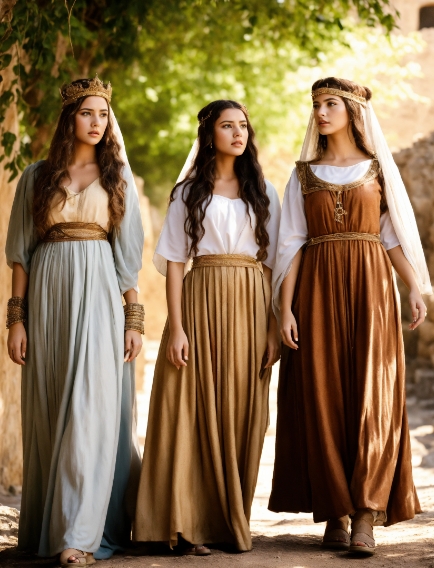
Medieval women’s clothing was both functional and decorative, with great attention paid to embroidery and accessories. From simple peasant dresses to elaborate noble attire, each garment told a story of status, occasion and contemporary fashion. Medieval costumes for women reflected evolving ideals of beauty and social conventions.
- Everyday and formal wear: Women’s medieval clothing varied widely depending on occasion and period. For daily wear, women of all classes wore simple tunics (called “cotte” or “chemise”) that reached the ground, often with a girdle at the waist. These garments were practical and allowed freedom of movement for daily tasks. In the High Middle Ages the “bliaut” emerged, a tunic more fitted at the torso with wide sleeves. For special events or ceremonies, noblewomen wore more elaborate and ornate dresses such as the “cotehardie” (fitted to the body) or the “houppelande” (a loose, voluminous tunic with wide sleeves popular in the Late Middle Ages), made from precious fabrics like silk, brocade or velvet and adorned with embroidery, pearls and gemstones. The difference between everyday wear and formal attire was pronounced, reflecting the wearer’s status and wealth and showcasing the diversity of medieval costumes.
- Accessories and complements: Accessories were an essential part of medieval female fashion, both for function and aesthetics. Hats and headdresses varied widely: from simple veils and coifs (worn by married women as a sign of modesty) to elaborate fabric-covered structures like “hennins” (tall pointed cones) or horn-shaped headdresses (bilobed), which indicated a woman’s social and marital status. Belts, often decorated with jewels or precious metals, were used to cinch garments and as attachment points for purses, keys and other personal items. Jewelry, such as rings, brooches (to fasten cloaks or necklines) and necklaces, added distinction and were especially popular among the upper classes. Shoes were generally simple, made of leather and fitted to the foot. Choosing these accessories was crucial to complete an authentic medieval outfit.
Medieval Men’s Costumes: Functionality and Power
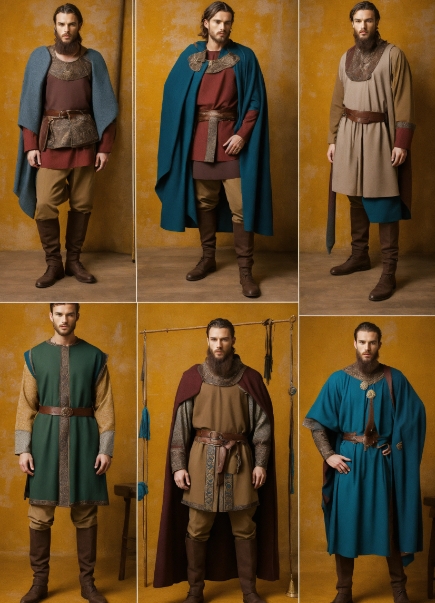
Similar to women’s fashion, men’s dress varied by status and occupation. Noblemen wore complex, ornate outfits while workers’ clothing was much simpler and practical. Medieval costumes for men evolved from loose tunics to more fitted garments that emphasized the figure, especially in the Late Middle Ages.
- Everyday and ceremonial outfits: As with women’s fashion, men’s medieval dress depended on occasion and social class. For daily work, men of lower classes wore hose (forerunners of trousers, which could be separate or joined) and short tunics (“cotte” or “tunic”) that allowed movement. Peasants and artisans also wore overgarments or gaiters to protect their clothes. On formal or ceremonial occasions, noblemen wore long, lavish tunics such as the “houppelande” (a voluminous garment with wide sleeves and a high collar popular in the 14th and 15th centuries), often with capes over them. In the Late Middle Ages, more body-hugging garments like the “pourpoint” or doublet became popular, worn over the shirt and under an overcoat. The materials and decoration of these outfits reflected the wearer’s rank and wealth, with the nobility favoring imported fabrics and luxurious adornments, making their medieval costumes true works of art.
- Accessories and armor: Men also used a variety of accessories that complemented their medieval costumes. These included belts for hanging swords and other weapons, purses (pouches), and hats of various shapes, from simple hoods to elaborate chaperons (a hood with a long “liripipe” that could be wrapped around the head) or caps. Armor was another important element of male dress in the nobility, especially for those involved in combat or tournaments. From mail hauberks (popular in the Early and High Middle Ages) to full plate armors (which were perfected in the Late Middle Ages), these items not only served for protection but also as symbols of power, status and chivalry. The evolution of armor is a fascinating chapter in the history of medieval costumes for men, showing constant innovation in materials and design for war and display.
Influence of the Church and the Nobility: Guardians of Medieval Fashion
The Church and the nobility not only dictated etiquette rules but also fashion trends. Dress restrictions sought to maintain social order, while colors and symbols used in clothing often had specific meanings. Their power was such that medieval costumes became a visual language of hierarchy and morality.
- Restrictions and dress regulations (Sumptuary laws): The Church and the nobility played crucial roles in setting dress norms during the Middle Ages. Sumptuary laws were enacted to limit luxury in dress and ensure that each social class could be easily identified by their attire. These laws restricted the use of certain fabrics (such as silk or velvet), colors (such as purple or scarlet), ornaments (exotic furs, jewelry, gold embroidery) and garment lengths (trains or excessively long sleeves) to the nobility and royalty, in an attempt to keep the social hierarchy visible and reinforced. Violating these laws could incur fines or even harsher punishments. The Church, for its part, promoted modesty and sobriety in dress, condemning vanity and excessive luxury, although its dignitaries often wore medieval costumes of great richness to reflect the glory of God and their own authority.
- Representative symbols and colors: The colors and symbols used in medieval dress often had specific meanings and were used to communicate messages about the wearer. Purple, for example, was reserved for royalty and high nobility, symbolizing power and wealth because of its high production cost. Red could indicate status or bravery, while blue, associated with the Virgin Mary, was a color of nobility and devotion. Religious symbols, such as crosses and images of saints, were common in the clothing of clergy and those associated with the Church, reflecting their devotion and role in society. Heraldic shields, embroidered on tunics, overgarments or banners, identified the loyalty and lineage of knights and nobles and were an integral part of their medieval costumes.
Events and Festivities: The Splendor of Special Medieval Costumes
During tournaments, religious celebrations and festivities, special medieval costumes were worn notable for their extravagance and beauty. These events offered the opportunity to display wealth and good taste through fashion, turning gatherings into visual spectacles.
- Costumes for tournaments and celebrations: During tournaments, weddings, royal banquets and other grand celebrations, men and women were expected to wear their most impressive attire. Knights participating in tournaments often wore armor elaborately decorated with their heraldic colors, and over it, surcoats or jupons embroidered with their family emblems. Court ladies adorned themselves with their finest dresses made of silks and brocades, with extravagant sleeves, pronounced necklines and long trains, complemented by dazzling jewelry and imposing headdresses such as hennins or butterfly-shaped headpieces. These events were occasions to display wealth, taste and social prestige, and medieval costumes were a fundamental part of this ostentation.
- Religious vestments and rituals: Religious festivities also required special garments, both for the clergy and the laity. Clerics and members of religious orders wore ceremonial vestments that varied according to occasion and rank within the Church, such as chasubles, dalmatics, stoles and mitres, often richly embroidered. During processions and religious rituals, the community might wear special clothing to reflect the solemnity of the event, often in colors and styles prescribed by tradition or ecclesiastical law. Brotherhoods and guilds also had their own uniforms or distinctive dress for their ceremonies and parades, adding another layer of diversity to the medieval costumes of the time.
Conservation and Replicas of Medieval Costumes: A Bridge to the Past
Today, museums and collectors work hard to conserve medieval costumes, while enthusiasts recreate detailed replicas for events and fairs, keeping history alive and allowing us to appreciate the craftsmanship and style of bygone eras.
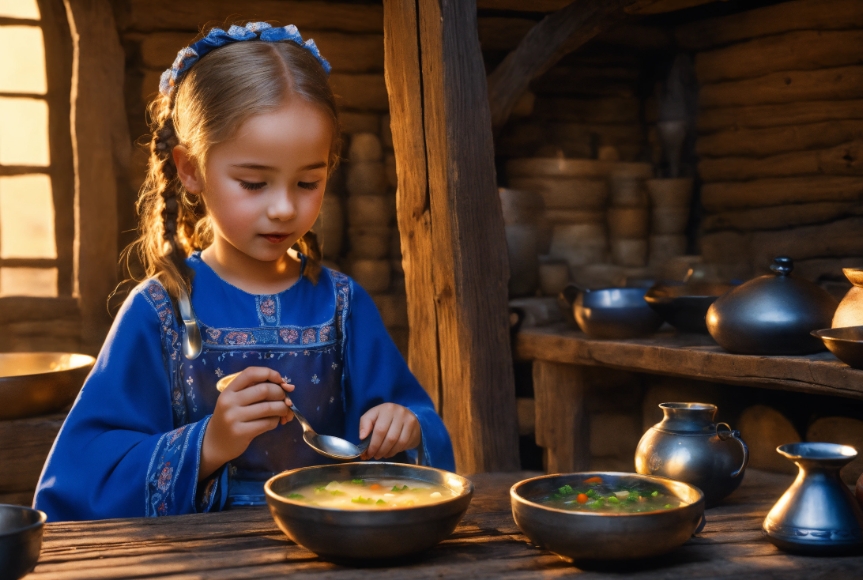
- Museums and collections: The conservation of medieval costumes is crucial for understanding the history and culture of this period. Given the fragility of ancient textiles, the survival of complete garments is rare, which makes existing pieces invaluable. Museums around the world house collections of clothing dating from the Middle Ages, carefully preserved under controlled temperature and humidity conditions to prevent deterioration. Institutions such as the Metropolitan Museum of Art in New York, the Victoria and Albert Museum in London, the Musée de Cluny in Paris and the Museo del Traje in Madrid have impressive collections of medieval textiles and garments. These pieces offer an invaluable window into the past, allowing historians and the general public to appreciate construction techniques, materials used and fashion trends of the time.
- Replica-making and its current relevance: Making replicas of medieval costumes plays an important role in historical education and cultural reenactment. Artists and craftsmen specialized in costume history use traditional techniques (such as hand sewing, patterns based on archaeological finds and manuscripts) and seek authentic or as-close-as-possible materials to the originals (wools dyed with natural dyes, open-weave linens, silks). These replicas are used not only in films, TV series and theatrical productions to add authenticity to historical portrayals, but also in medieval fairs, reenactment events and LARP (Live Action Role-Playing) communities. They allow people to experience first-hand the clothing and life of the Middle Ages, fostering a deeper and more tangible understanding of history.
“Medieval Costumes” in Popular Culture: A Living Legacy
The fascination with medieval fashion transcends the historical field, influencing cinema, literature and theatre, and generating ongoing interest in themed fairs and festivals that celebrate this rich cultural heritage. Medieval costumes have become a cultural icon, adapting and reinventing themselves in the collective imagination.
- Influence in film, literature and theatre: The fascination with the Middle Ages and its medieval costumes is widely reflected in contemporary popular culture. Films and TV series such as “Game of Thrones”, “Vikings”, “The Lord of the Rings” or “The Last Kingdom” have popularized the medieval aesthetic, showing everything from elaborate court gowns to battle armor. Historical plays and musicals also draw on period clothing to create rich, visually impressive worlds that capture the public’s imagination. This influence not only revives interest in medieval history and fashion but also introduces a modern interpretation of these elements, adapting them to current aesthetic sensibilities and preferences, often with a touch of fantasy.
- Medieval festivals and fairs: Medieval festivals and fairs are popular events that celebrate the history and culture of the Middle Ages, attracting people of all ages and backgrounds. At these events, participants often dress in medieval costumes, take part in activities such as jousts, banquets, artisan markets and workshops on ancient crafts, and enjoy entertainments like period music, dance and theatre. These celebrations not only offer fun and education but also provide a community for those interested in medieval history, historical reenactment and LARP, where the authenticity of medieval costumes is a key component of immersion.
Exploring medieval costumes is to immerse oneself in a world of color, texture and meaning, where each garment tells the story of an era defined by rigid social structures and rich cultural diversity. From the humble tunics of peasants to the sumptuous garments of royalty, each outfit was a testimony to the life, beliefs and status of those who wore it. Through the conservation and recreation of these garments, we keep the legacy of a fascinating past alive, allowing us to appreciate the complexity and beauty of medieval fashion and its enduring influence on our contemporary culture.
SEE THE FULL COLLECTION OF MEDIEVAL COSTUMES | SEE ACCESSORIES FOR MEDIEVAL COSTUMES


